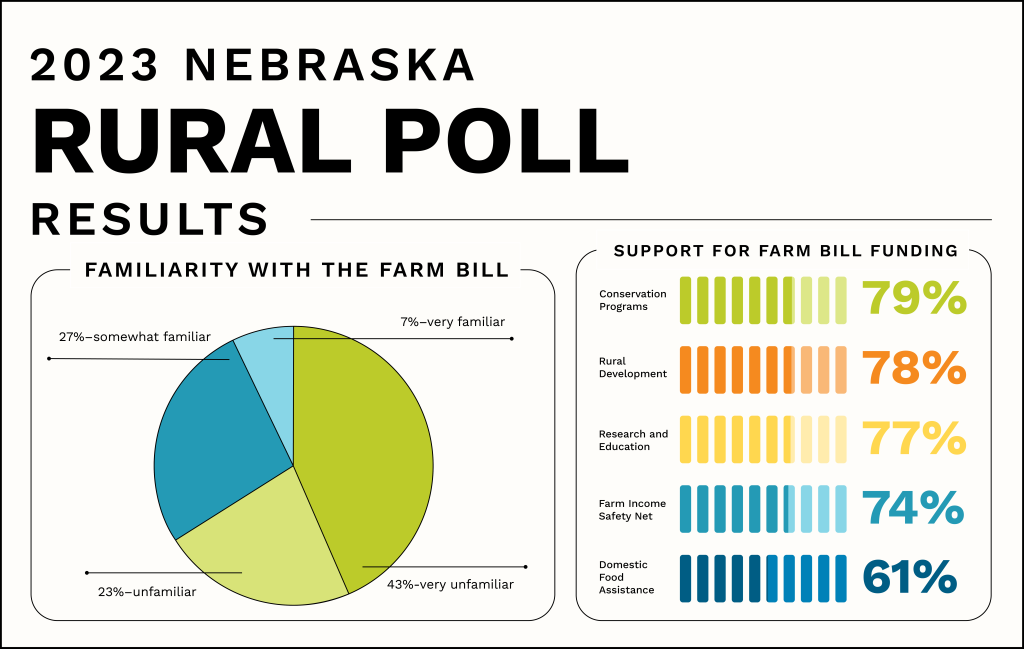Becky Vogt, December 8, 2023
Poll: Most rural Nebraskans unfamiliar with Farm Bill but support programs
Most rural Nebraskans report being unfamiliar with the Farm Bill and federal agricultural policy, according to the 2023 Nebraska Rural Poll.
Two-thirds of rural Nebraskans surveyed are either very unfamiliar (43%) or somewhat unfamiliar (23%) with federal ag policy. Twenty-seven percent are somewhat familiar, and only 7% report being very familiar.
According to the poll, Nebraskans who work in agriculture are more likely than others to report being familiar with ag policy. Just more than 60% of ag workers are at least somewhat familiar. Other demographic groups that are more likely to be familiar with ag policy include those living in or near smaller communities, residents of both the North Central and Northeast regions of the state, older adults, men, married people, and Nebraskans with higher education levels.
Federal agricultural policy, also known as the Farm Bill, encompasses all things related to agriculture and food. This includes not only farm income safety net and conservation programs, but domestic food assistance programs (such as the Supplemental Nutrition Assistance Program), rural development (which funds services such as broadband, utilities and housing programs) and programs focused on specific producers and crops.
Although most respondents report being unfamiliar with the Farm Bill, they generally support federal spending for most Farm Bill programs. Almost eight in 10 respondents support federal funding for conservation programs (79%), rural development (78%), and research and education programs (77%). On the other hand, just 35% support funding for international food assistance programs.

Domestic food assistance programs, which make up most of the Farm Bill spending, are either greatly or somewhat supported by more than 60% of respondents. Nebraskans from lower income households are more likely to support funding for such programs. Seventy-three percent of respondents with household incomes under $40,000 support funding for these programs, compared to about 60% of those with higher incomes.
“It may seem ironic that rural Nebraskans can be both unfamiliar with the Farm Bill yet supportive of the broad categories of Farm Bill programs, but Farm Bills are like many pieces of federal legislation that include numerous programs that appeal to broad groups of citizens,” said Brad Lubben, Nebraska Extension specialist in agricultural policy. “The whole may be too complex for many to follow closely, but the pieces are each important to various groups and together lead to the coalition that regularly supports a Farm Bill.”
Panhandle residents surveyed were more likely than others to support funding for many of the listed programs: agricultural trade promotion and development, research and education, programs focused on targeted producers (small, beginning, traditionally underserved, etc.), programs focused on plant and animal health protection, and programs focused on specialty crop or local food systems.
Cheryl Burkhart-Kriesel, a Nebraska Extension specialist with Rural Prosperity Nebraska, said she wasn’t surprised by the strong Panhandle support.
“The Panhandle’s diversified agricultural economy has created several unique processing and value-added enterprises,” she said. “If you live in the region, you see the connection between agriculture and economic development. Federal programs that provide price stability and grow the agricultural base benefit our residents in the long run.”
The Rural Poll is the largest annual poll gauging rural Nebraskans’ perceptions about policy and quality of life. Questionnaires were mailed to more than 6,000 households in Nebraska in late spring and summer, with 1,100 households — representing 86 of the state’s 93 counties — responding. The margin of error is plus-or-minus 3%. The University of Nebraska–Lincoln’s Department of Agricultural Economics conducts the poll with funding from Nebraska Extension. For the full report, click here.





